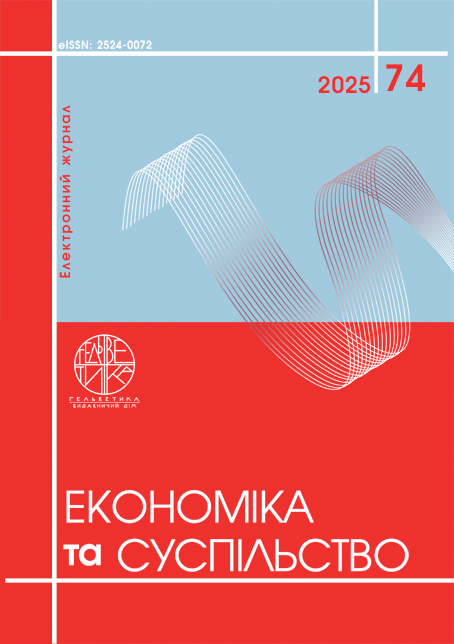STRATEGIC MANAGEMENT IN DECENTRALIZED SYSTEMS: THE BITCOIN MODEL FOR MINIMIZING THE RISKS OF OWN ASYMMETRY IN BUSINESS
Abstract
The article analyzes the Bitcoin model as an innovative approach to strategic management that allows minimizing the risks of power asymmetry in the business environment. The study examines the architecture of decentralized systems through the prism of the theoretical concepts of power of Stephen Lukes, revealing the mechanisms of neutralization of power relations in the Bitcoin protocol. The study compares the classical models of power asymmetry in organizational structures with the principles of decentralized management based on blockchain technologies. The authors demonstrate how the consensus protocol underlying Bitcoin allows overcoming the "three dimensions of power": the direct exercise of power, the formation of the agenda, and the influence on the preferences of subjects. Particular attention is paid to the analysis of the concept of "interest alignment" of participants in decentralized systems and methods of its application in business practices. Based on the analysis, a typology of strategic business models based on the principles of decentralized management is proposed, including decentralized autonomous organizations, hybrid centralized-decentralized models, protocol platforms, distributed collaborative networks, and tokenized business ecosystems. Specific mechanisms for neutralizing power asymmetry and strategic advantages are defined for each model. A complex typology of risks of introducing decentralized management models into business practices has been developed, including organizational, technological, regulatory and strategic categories. Minimization strategies adapted to the specifics of business contexts are proposed for each type of risk. The research results demonstrate that the principles of decentralized management, borrowed from the Bitcoin model, can be effectively adapted for the transformation of strategic management in business in order to reduce the risks of power asymmetry. The key principles of such adaptation are: separation of information flows, alignment of interests of participants through economic incentives, elimination of single points of failure, and replacement of trust in institutions with trust in the protocol. The practical significance of the study lies in the development of conceptual foundations and recommendations for implementing the principles of decentralized management in strategic business practices to increase the resilience of organizations to external influences and reduce the risks of power asymmetry.
References
Bachrach P., Baratz M. S. Two Faces of Power. American Political Science Review. 1962. Vol. 56, № 4. P. 947-952. DOI: https://doi.org/10.2307/1952796.
Berg C., Davidson S., Potts J. Understanding the Blockchain Economy: An Introduction to Institutional Cryptoeconomics. Cheltenham: Edward Elgar Publishing, 2020. 192 p.
Callon M. Some Elements of a Sociology of Translation: Domestication of the Scallops and the Fishermen of St Brieuc Bay. The Sociological Review. 1984. Vol. 32, № 1_suppl. P. 196-233. DOI: https://doi.org/10.1111/j.1467-954X.1984.tb00113.x.
Catalini C., Gans J. S. Some Simple Economics of the Blockchain. Communications of the ACM. 2020. Vol. 63, № 7. P. 80-90. DOI: https://doi.org/10.1145/3359552.
Dahl R. A. A Critique of the Ruling Elite Model. American Political Science Review. 1958. Vol. 52, № 2. P. 463-469.
Davidson S., De Filippi P., Potts J. Blockchains and the Economic Institutions of Capitalism. Journal of Institutional Economics. 2018. Vol. 14, № 4. P. 639-658.
De Filippi P., Mannan M., Reijers W. Blockchain as a Confidence Machine: The Problem of Trust & Challenges of Governance. Technology in Society. 2020. Vol. 62. 101284. DOI: https://doi.org/10.1016/j.techsoc.2020.101284.
Favier J., Takkal Bataille A. Bitcoin – la Monnaie Acéphale (2e édition) [Bitcoin – The Acephalous Currency (2nd edition)]. Québec: Éditions du Centre National de la Recherche Scientifique, 2023. 299 p. (in French).
Hayek F. A. The Use of Knowledge in Society. The American Economic Review. 1945. Vol. 35, № 4. P. 519-530. URL: http://www.jstor.org/stable/1809376 (дата звернення: 11.03.2025).
Hudoshnyk O., Krupskyi O. P. Science and comics: from popularization to the discipline of Comics Studies. History of Science and Technology. 2022. Vol. 12, № 2. P. 210-230. DOI: https://doi.org/10.32703/2415-7422-2022-12-2-210-230.
Lamport L., Shostak R., Pease M. The Byzantine Generals Problem. ACM Transactions on Programming Languages and Systems. 1982. Vol. 4, № 3. P. 382-401. DOI: https://doi.org/10.1145/357172.357176.
Lukes S. Power: A Radical View. London: Macmillan, 1974. 64 p.
Lukes S. Power: A Radical View. (Second edition). Hampshire: Palgrave Macmillan, 2004. 192 p.
Lukes S. Power: A Radical View. (Third edition). London: Bloomsbury Academic, Red Globe Press, 2021. 238 p.
Mills C. W. The Power Elite. New York : Oxford University Press, 1956. 423 p.
Morganti G., Schiavone E., Bondavalli A. Risk Assessment of Blockchain Technology. 2018 Eighth Latin-American Symposium on Dependable Computing (LADC). Foz do Iguacu, Brazil, 2018. С. 87-96.
Nakamoto S. Bitcoin: A Peer-to-Peer Electronic Cash System. 2008. URL: https://bitcoin.org/bitcoin.pdf (дата звернення: 11.03.2025).
Pavlov R., Zarutska O., Pavlova T., Grynko T., Levkovich O., Hordieieva-Herasymova L. Blockchain as a Management Technology: Institutionalization of Crypto-Assets and Transformation of Entrepreneurial Models Using the Example of Ethereum. Financial and Credit Activity Problems of Theory and Practice. 2024. Vol. 6, № 59. P. 151-166. DOI: https://doi.org/10.55643/fcaptp.6.59.2024.4529.
Spinoza B. Ethics. In E. Curley (Ed. & Trans.), The Collected Works of Spinoza (Vol. 1, pp. 408-617). Princeton: Princeton University Press. (Original work published 1677).
Yermack D. Corporate Governance and Blockchains. Review of Finance. 2017. Vol. 21, № 1. P. 7-31. DOI: https://doi.org/10.1093/rof/rfw074.
Zucker L. G. Production of Trust: Institutional Sources of Economic Structure, 1840-1920. Research in Organizational Behavior. 1986. Vol. 8. P. 53-111.
Bachrach, P., & Baratz, M. S. (1962). Two Faces of Power. American Political Science Review, 56(4), 947-952. https://doi.org/10.2307/1952796.
Berg, C., Davidson, S., & Potts, J. (2020). Understanding the Blockchain Economy: An Introduction to Institutional Cryptoeconomics. Cheltenham: Edward Elgar Publishing.
Callon, M. (1984). Some Elements of a Sociology of Translation: Domestication of the Scallops and the Fishermen of St Brieuc Bay. The Sociological Review, 32(1_suppl), 196-233. https://doi.org/10.1111/j.1467-954X.1984.tb00113.x.
Catalini, C., & Gans, J. S. (2020). Some Simple Economics of the Blockchain. Communications of the ACM, 63(7), 80-90. https://doi.org/10.1145/3359552.
Dahl, R. A. (1958). A Critique of the Ruling Elite Model. American Political Science Review, 52(2), 463-469.
Davidson, S., De Filippi, P., & Potts, J. (2018). Blockchains and the Economic Institutions of Capitalism. Journal of Institutional Economics, 14(4), 639-658.
De Filippi, P., Mannan, M., & Reijers, W. (2020). Blockchain as a Confidence Machine: The Problem of Trust & Challenges of Governance. Technology in Society, 62, 101284. https://doi.org/10.1016/j.techsoc.2020.101284.
Favier, J., & Takkal Bataille, A. (2023). Bitcoin – la Monnaie Acéphale (2e édition) [Bitcoin – The Acephalous Currency (2nd edition)]. Québec: Éditions du Centre National de la Recherche Scientifique. [in French].
Hayek, F. A. (1945). The Use of Knowledge in Society. The American Economic Review, 35(4), 519–530. URL: http://www.jstor.org/stable/1809376.
Hudoshnyk, O., & Krupskyi, O. P. (2022). Science and comics: from popularization to the discipline of Comics Studies. History of Science and Technology, 12(2), 210-230. https://doi.org/10.32703/2415-7422-2022-12-2-210-230.
Lamport, L., Shostak, R., & Pease, M. (1982). The Byzantine Generals Problem. ACM Transactions on Programming Languages and Systems, 4(3), 382-401. https://doi.org/10.1145/357172.357176.
Lukes, S. (1974). Power: A Radical View. London: Macmillan.
Lukes, S. (2004). Power: A Radical View (Second edition). Hampshire: Palgrave Macmillan.
Lukes, S. (2021). Power: A Radical View (Third edition). London: Bloomsbury Academic, Red Globe Press.
Mills, C. Wright. 1956. The Power Elite. New York: Oxford University Press.
Morganti, G., Schiavone, E., & Bondavalli, A. (2018). Risk Assessment of Blockchain Technology. In 2018 Eighth Latin-American Symposium on Dependable Computing (LADC), Foz do Iguacu, Brazil (pp. 87-96).
Nakamoto, S. (2008). Bitcoin: A Peer-to-Peer Electronic Cash System. URL: https://bitcoin.org/bitcoin.pdf.
Pavlov, R., Zarutska, O., Pavlova, T., Grynko, T., Levkovich, O., & Hordieieva-Herasymova, L. (2024). Blockchain as a Management Technology: Institutionalization of Crypto-Assets and Transformation of Entrepreneurial Models Using the Example of Ethereum. Financial and Credit Activity Problems of Theory and Practice, 6(59), 151-166. https://doi.org/10.55643/fcaptp.6.59.2024.4529.
Spinoza, B. (1985). Ethics. In E. Curley (Ed. & Trans.), The Collected Works of Spinoza (Vol. 1, pp. 408-617). Princeton University Press. (Original work published 1677).
Yermack, D. (2017). Corporate Governance and Blockchains. Review of Finance, 21(1), 7-31. https://doi.org/10.1093/rof/rfw074.
Zucker, L. G. (1986). Production of Trust: Institutional Sources of Economic Structure, 1840-1920. Research in Organizational Behavior, 8, 53-111.

This work is licensed under a Creative Commons Attribution 4.0 International License.


